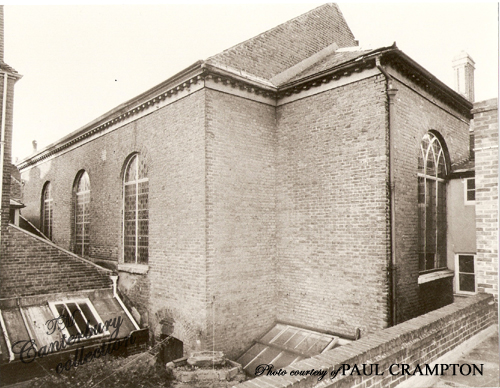~ ST. ANDREW'S CHURCH ~
CANTERBURY
The old church was located in the middle of HIGH STREET (now PARADE) was called "The Middle Row"
The register dates from 1538, and it also has a churchwardens' accounts from 1483
CCA-DCc-ChAnt/C/693-724 This section relates
to St Andrew's parish, Canterbury. DCc-Register/A, ff413r-421v contains
47 charters for St Andrew's and there are 37 charters for St Andrew's
in DCc-Register/E, ff118r-123v. There are no original charters for a
significant number of these registered versions. - Canterbury Cathedral
Archives
St. Andrew was taken down in 1763, rebuilt, closed in the 1880's, and demolished in 1956
Consecrated July 4, 1774, by the archbishop, and was the first in the diocese consecrated since the reformation
Acts of Parliament - No., 204 3 Geo. III. c. 49 (1763) For taking down the Parish Church of St. Andrew in the City of Canterbury, and for building a new Church in a more convenient place.
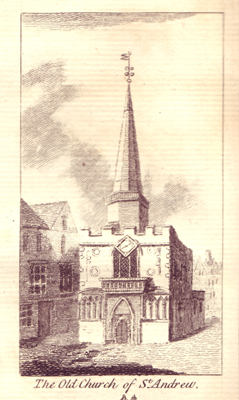
Detail from the map found in "A walk in and about the city of Canterbury with many observations not to be found in any description hitherto published", the second edition, by William Gostling, M.A. 1777
On an oval table of white marble in St. Martins, Canterbury
"In Memory of
Mrs. Ann Hulse
(interred near this place)
who died the XVIIth June, MDCCLXXX, **17th June, 1780
in the LXVIITH year of her age. **67
Her character was most justly
distinguished by an unremitted attention
to the discharge of every moral
and religious duty.
Shew as the daughr of Nathaniel and
Ann Hulse, of the parish of St. Andrew's
in the City of Canterbury,
Whose remains
(with those of three of their
children) are deposited in the
spot on which the church
of that parish
formerly stood."
Arms, in a lozenge, Ar. three piles, one issuing from chief, and two base S.
"The west door of the church was at the crossing between Mercery Lane and St. Margaret's Street. It must have been quite on the road as constant reference is made in the Accounts to the payment for it's cleaning. Behind the church to the east was Archbishop Abbott's conduit, removed in 1754; this stood opposite the opening to Angel, now Butchery Lane."
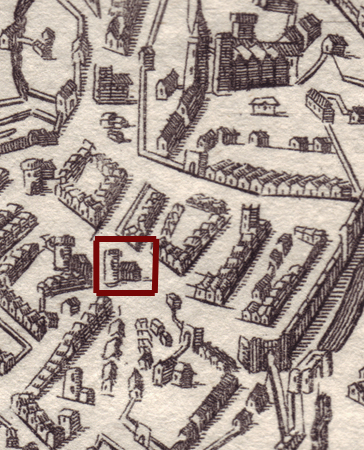
"Procession at declaration of War, Sat. 7 April 1744. Declaration read at Bullstake, at St Andrew's church, at Iron Cross or Three Tuns Corner, and at Guildhall, whence adjournment made to Fountain Tavern." Alderman Gray's Notebook 1737-1780
Presentments 8 June 1536, Walter Hoker, apothecary for speaking against images, worshiping of saints. On May day last when he was married in the church of Canterbury St Andrew he was obstinate about kissing the priest. CC/JQ/335/ii 1536
1679. Every inhabitant, within the city
and liberties, is to watch, in his own person, by turns, or provide
a sufficient man in his stead; and the watch is every night, to consist
of 16 able men, who are to watch from ten at night, until four in the
morning. Their stand is at the door of St. Andrew's church.
1754. The old conduit, by St. Andrew's church, is taken down, the lead of which sells for 124l 13s. 2 1/2d. New reservoirs of water are placed in the towers of St. George's gate. Margaret Mantle is executed for the murder of her male bastard child, and her body given to the surgeons for dissection.
1762. The mayor and commonalty give 100l towards rebuilding St. Andrew's church; for which purpose an Act of Parliament passes.
Hasted
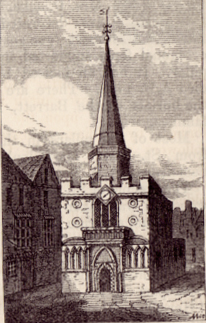
Drawing of St. Andrew's Church from John Brent, Canterbury in the Olden Time 1879
The Sanctus Bell: "The Wackerell." - In the churchwardens' accounts of St. Andrew's, Canterbury, are these entries (amongst others) relating to the "wackerell":
1510. Payd for a cord for the wakrell. It. For gogyns and other smale gere.
1517. for the makyng of a whylle to the wacrell.
1519. for a baldryk to the wackerell."
There are other entries showing the wackerell was rung with a cord, while the other bells had "ropys." Query, whence the derivation of "wackerell"? Is the word known outside of Kent? Thomas North, Notes and Queries
An Inscription on a monument placed against the South Wall in St. Andrew's Church, Canterbury, which is soon to be taken down, the following has been thought worth preserving, as it points out the Ancestry of that great Man, Dean Swift.
Near to this place lies buried the bodies of Mr. Thomas Swift, Rector of this church 22 years, a reverend Preacher of God's Word. He died the 12th of June, 1592, aged 57.
And of Mr. William Swift, his son, who succeeded him in this church 33 years. He was Rector of Harbal Downe 22 years, and a painful pastor in both cures, aged 58, and died the 24th of Oct. 1624.
Margaret, wife of Mr. Thomas, lyeth in the Cathedral Church yard, against the South Door, with nine of her children. Mary, wife of Mr. William lyeth buried with him. She died the 5th of March, 1686, aged 58. They left issue one son, Mr. Thomas Swift, Preacher, in Herefordshire, and two daughters, Katharine, wife of Thomas Withierden, Gentleman and Margaret, wife of Henry Atkinson, Pothecary and Citizen of London: by which two daughters this monument was erected.
N.B. Mr. Thomas Swift, the Survivor, was Vicar of Goodridge, Herefordshire, and has six sons; one of whom, named Jonathan, was the father of Jonathan, the famous Dean of St. Patrick's, who died in October 1745. (Vide Lord Orrery's first Letter to his son Hamilton Boyle.)
The Gentleman's and London Magazine 1764
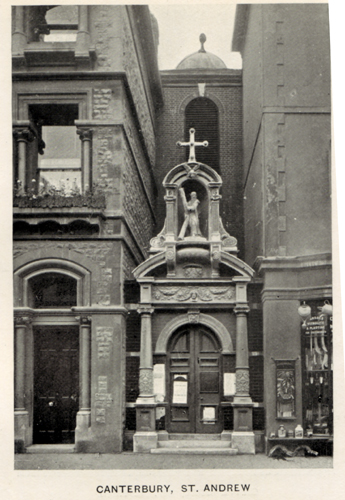
"A handsome gateway in the Renaissance style, surmounted with a statue of St. Andrew, forms the entrance from the Parade" 1913
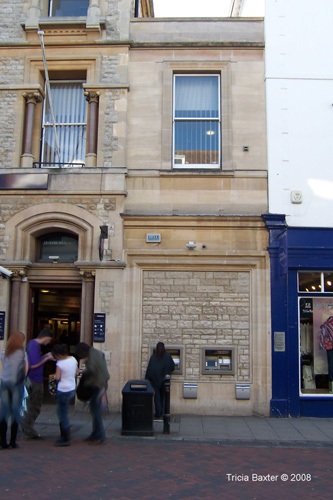
The space where St. Andrew's Gate used to be is now an instant teller
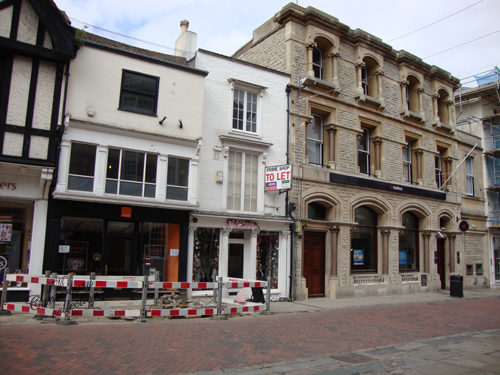
"Dean Swift's family. - I recently met with the enclosed newspaper cutting, dated March, 1765, which may be worth reprinting, as it is possible that the monuments here described as exisitng at Canterbury may have since perished: To the printer of "Lloyd's Evening News" Canterbury, March 6.
"Sir - On surveying the old monuments, &c., which are now putting up in St. Andrew's church in this city (having been removed from the old church when it was taken down a few years ago) I saw an old curious tablet, of which I have sent you a transcript: and also took particular notice of the coat of arms of the Swifts, Dean Swift's ancestors, formerly Rectors of that parish, vis. an anchor and dolphin, as it reminded me of a passage on that subject in one of his letters to Stella, dated Feb. 24, 1711-12, vis. "Pray be so kind as to step to my aunt, and take notice of my great grandfather's picture. You know he has a ring on his finger, with a seal of an anchor and dolphin about it; but I think there is besides, at the bottom of the picture, the same coat of arms quartered with another, which, I suppose, was my great grandmother's. If this be so, it is a stronger argument than the seal. And pray see whether you think that the coat of arms was drawn at the same time with the picture, or whether it be of a later hand, and ask my aunt what she knows about it. My reason is because I would ask some Herald here, whether I should chuse that coat, or one in Guillim's large folio of Heraldry, where my uncle Godwin is named with another coat of arms of three stags; (viz. or a chevron nebule, argent and azure, between three bucks in full course, vert).
"Mr. William Swift, the Dean's great grandfather above mentioned (who died in 1624), was the younger of the two Rectors of St. Andrew's. What induced Godwin Swift his eldest grandson, to alter his arms, and what arms are now borne by the Swifts, particularly Deane Swift, Esq., of Goodrick, his immediate descendant. I leave to be discussed by abler Heralds, and am, Sir Yours, &c. J.D.
P.S. It is remarkable that Dr. Swift himself was so ignorant of his ancestors that, in his Sketch of his of Life, he styles Mr. William Swift a Prebendary of Canterbury; but by his epitaph he appears to have held on other preferment with this living, except the rectory of Harbledown."
The following is copied from a small Tablet in St. Andrew's Church, Canterbury.
Semper quicquid facio audire mihi videor sonitum tubee clangentis, Surgite mortui, et venite ad judicium. Hieronymus.
Mors mortis morti mortem nisi morte dedisset AEternae vitae janua clausa foret.
Hoc nobis spondent Sanctorum carmina vatum,
Et verbum verum, maxime Christe, tuum.
Tunc Deus ex tumulis homines deducet in auras,
Ac rursus veteri veatiet ossa cute.
In pace
igitur hic requiescunt
ossa Thomae Swift, quondam
rectoris istius ecclesiae, qui duodecimo die
mensis Junii Anno Domini 1592 animam
effavit, ac moriens gregem hanc sibi a
domino commissam filio suo reliquit.
fui, non sum, estis, non eritis.
Ubi igitur tua, O mors, victoria
Ubi tuus, O sepulchrum, animus
CHRISTI 'XORS'MEA'VITA.
Hodie mihi, cras alteri.
"....But to return into the city, through St. George's gate. At a small distance on the right is the parish church of St. George; a little lower, on the opposite side, is the gate-way of the White Friars. Farther on, on the right, are the shambles, which, till the year 1740, stood in the middle of the street; here also is a fish-market, lately established, for the sale of fish, toll-free. Adjoining is a public engine for weighing loads of hay; and near this is the corn-market with a granary over it. This part of the street had a middle row of considerable length, consisting of the shambles, a fine conduit or water house of stone, and the parish church of St. Andrew. The conduit was pulled down in 1754, and the church in 1763; a new church is built just by, which was opened for the performance of divine service December 26, 1773, and consecrated the July following. The Kentish Traveller's Companion 1776
May 13, 1787, marriage at Canterbury, Rev. William Gregory, rector of St. Andrew's, and one of the six preachers in the Cathedral, to Miss Catherine Sayer, 2nd daughter of the late George Sayer esq., of Pett, Kent. The Gentlemen's Magazine 1787
Marriage October, 1794, at St. Andrew's Canterbury, Mr. Joshua WILKINSON, surgeon, of London to Miss Sarah PATTESON, youngest daughter of Mr. William PATTESON of Canterbury. Kentish Register 1795
Isaac TERRY, M.A. Rector of St. Mary, Bredman, and St. Andrew, in Canterbury. "Sixteen Sermons upon select subjects.," Cant. 1746, 8vo. Bibliotheca Britannica 1824
1807, death at Canterbury, Mr. Edward Burgess, upwards of thirty years clerk of the parish of St. Andrew, 80.
"St. Andrew's, a modern structure of brick, has been erected since 1764, in place of the more ancient Church of the same name which stood in the middle of the street, and was taken down under an Act passed in that year. Among the Rectors of this Parish, who were buried in the old Church, and the memorials of whom were placed in the new vestibule, were the Rev. Thomas and William Swift, the great great grandfather, and great grandfather, of the celebrated Dean Swift: the former died in June, 1592; the latter in October, 1624."
Topographical, Historical, Descriptive, and Literary, Delineation's in Kent, E.W. Brayley, October, 1807 & The Beauties of England and Wales, 1808
1838
Patrons, The Archbishop of Canterbury, 2 turns; the Dean and Chapter, 1 turn
Incumbent & Rector - W. Spencer Harris BRAHAM, Green Court
Churchwardens:
Thomas MASON, Butchery Lane
Frederick Freeman COBB, Butter market
Parish Clerk, J. PENN, Burgate Street
Sexton, J. PENN, junr. Iron Bar Lane
"Higher up High-street, just above where St. Margaret's-street and Mercery-lane cross it, in the middle of the street, formerly stood St. Andrew's Church, a narrow lane being left on each side of it, for the public thoroughfare. This church was pulled down in 1764, and a new one erected on the south side of the street. Just above it stood a large conduit, built by Archbishop Abbot, and further up some ancient timbered meat shambles, both of which have been pulled down, so that now the whole width is laid open, greatly to the accommodation of the public and beauty of this street."
Canterbury Guide, Henry Ward 1843
"A.D. 1746, the conduit kept near St. Andrew's Church was illuminated upon the marriage of a Sir Edward Hales. Eight years later the conduit was removed."
John Brent 1879
"We are informed by an epitaph, once in the old church of St. Andrew, "That Stephen White, citizen (who died, A.D. 1592), was the first ironmonger that ever was dwelling in the city of Canterbury."
John Brent 1860
"In 1388 the Corn Market was in St. Andrew's, where also, in 1462, there was the common Butchery, which was carried on with shambles standing behind St. Andrew's Church."
Felix Summerly
"St. Andrew's Church stands in a small recess, on the south side of the Parade. It is a plain unpretending edifice of red brick, with two aisles, a chancel, and square tower, and was built to replace the old church which stood in the middle of the road, for which an Act of Parliament was obtained in 1762. The living is a rectory, and was in the possession of the convent of St. Augustine, until the time of the Reformation, when it was given to the Archbishop of Canterbury. It was united with St. Mary Bredman, in 1681, and the patronage then fell into the hands of the Archbishop, and the Dean and Chapter cojointly; the former having two appointments, and the latter one."
Directory 1847
"The church of St. Andrew, which formerly stood in the middle of the High Street near its junction with St. Margaret's street and Mercery Lane, was pulled down in the middle of the last century and replaced in 1774 by a brick edifice, erected on a site a little withdrawn from the street; this church, however, was closed in 1880 and a faculty has been obtained for it's removal. The register of St. Andrew's dates from 1538." Directory of Kent 1882
RECTORS
John Cox, S.T.P. ob. 1544 *also spelt Cockys
William Morphet, ind. Dec. 22, 1565
Henry Morray, July 3, 1570
Thomas Swift, A.M. March 18, 1572 obt. June 12, 1592
William Swift, A.M. July 8, 1592 obt. Oct. 24, 1624
Edward Aldey, A.M. Nov. 6, 1624 obt. July 12, 1673
Arthur Kay, S.T.P. July 18, 1673, obt. 1701
All these rectors here mentioned to Dr. Kay inclusive, were buried in the old church, under the site where it once stood, their remains still rest.
St. Andrew's church stands in a small recess, about the middle of the High-street, on the south side. It was built in the room of the ancient church of the same name, which stood at a small distance, in the centre of the street, the passage along which was through two narrow lanes on each side of it. This church was an ancient structure of only one isle, and one chancel, having a spire steeple at the west end; in it were many monuments and inscriptions; the former of which, when this church was pulled down in 1764, an act of parliament having been obtained for this purpose, for the accommodation of the public by laying open the street, were at first deposited in the undercroft of the cathedral; but when the new church was finished, they were placed in the vestibule of it; an account of them will be given below. Among these were the several monuments of the rectors of this parish, from Dr. Cox in 1544, to Mr. Paris, who died in 1709, both inclusive, and were for the most part buried in it. Among these it is observable, that there were two ancestors of the famous dean of St. Patrick's viz. Thomas Swift, his great-grandfather, and William his son, who were successively rectors of this church from 1569 to 1624; the former of them having expressly desired by his will, that his bones should rest in that church, where his people so entirely loved him.
This church being thus taken down, a new one was erected, though not till some years afterwards, on a spot of ground bought for the purpose, of sufficient size for a small cemetery likewise adjoining*. This church, which is a neat building of brick, with a steeple of the same materials, in which hangs one bell, was opened by licence from the archbishop, for the performance of divine service, on December 26, 1773, and was consecrated, with the church-yard, on the 4th of July following.
It appears by the return made by the king's commissioners, anno 2 Edward VI. that there were obit and lamp lands given by the wills of several persons for the keeping of their several obits yearly, and finding lamps within the parish church for ever.
In a will anno 1534, I find mention of St. Ninian's light, in this church.
This church is a rectory, the patronage of which was part of the possessions of the abbot and convent of St. Augustine, with which it continued till the final dissolution of it in the 30th year of king Henry VIII. when it was, with the rest of the possessions of that monastery, surrendered into the king's hands; whence it was afterwards granted by the king, in his 34th year, in exchange, and with other premises, to the archbishop of Canterbury; but upon its being united in 1681 to St. Mary Bredman's rectory, (which was of the patronage of the priory of Christ-church, and on the dissolution of it had been given to the dean and chapter of Canterbury); that being the mother church to the smaller parish, the right of patronage of these united churches was decreed to the archbishop and the dean and chapter of Canterbury jointly; that is to say two turns to the archbishop, and one turn of presentation to the dean and chapter. In which state the patronage of it continues at this time.
The church of St. Andrew was valued in the ancient taxation, at 8l. per annum.
This rectory, with that of St. Mary Bredman united, is valued in the king's books at 22l. 6s. 8d. and the yearly tenths at 2l. 4s. 8d. In 1588 it was valued at sixty pounds. Communicants two hundred. In 1640 it was valued at eighty pounds, the like number of communicants.
There is a terrier of this rectory, dated anno 1630, in the registry of the consistory court of Canterbury. During this time, these two churches of St. Andrew and St. Mary Breadman appear to have been united; a list of the future rectors of which may be seen hereafter in the account of the latter, which is the mother church.
*In the old church there were in Mr. Somner's time, several brass plates and inscriptions for Stephen White, citizen and the first ironmonger that ever was dwelling in this city ob. 1592; and in the windows, the figure and an inscription on the glass, Orate paia Dni Wilmi Mellrose Recotris Eccle seae Maria de Bredman. And in another the figure and an inscription, Orate p aia patris Johis Fanting Rectoris Sea Maria de Bredyn-Det Mater Xti Fanting John Gaudia Coeli. These, perhaps, were benefactors to the church about the time that John Petyt of this parish was; who by his will in 1498, gave five marcs to the making a new steeple and a new roof of it. And one John Swan, a parishioner and an alderman, and sometime mayor, gave in like manor 66s. 8d. towards the work of a new roof and steeple here, when it should happen to be made. In this church was a chantry for one William Butler. In Gostlings Canterbury, there is a neatly engraved view of this old church.
*The ground was purchased and the church built, partly by the parish rates and partly by the collection of private contributions; the expense of the ground and building amounted in the whole to £1900.
The History and Topographical Survey of the County of Kent, Edward Hasted 1801
The Will of William Benet
William Benet, son of Robert Benet, of the parish of St. Andrew in Canterbury. My body to be buried in the Church of St. Augustin, beside Alice my wife. I will 1111s. 1111d. of quit-rent of the tenement of William Fellow, and now the tenement of John Robinson, also chapman in Clement's lane, the which said rent I will that my feoffees, the Parson of St. Andrew's, and the two Wardens of the said Church, have to sustain to keep up the clock of the said Church forevermore. Forasmuch as the Wardens of St. Andrew's have no good in hand, as other Churches have, I will that my executors deliver it to the said Church. I will that my executors buy three hundred feet of Ashler of Folkestone stone, to make a wharf about the King's Melle there. I bequeath vl. for the reparation of the shambles for strange butchers to occupy every market day; for paving the streets from St. Andrew's to the Pillory, that the people may go the cleaner thereto, xl. I will that Thomas atte Wode have the Beme at Castelgate, with the lands thereto belonging, the which be rehearsed in the bills indented made between the said Thomas and me, he fulfilling the covenants of the same. I will that John a Neve, of Berham, have all the lands and pastures, and X111d. of quit-rent, that I have in the parish of Berham, as it is rehearsed in the bills indented made between the said John and me, the said John a Neve fulfilling the covenants rehearsed in the said bills. I will to certain trustees all the tenements that I have in the parish of St. Mary Bredman, beside Juey-lane, to the welfare and common profit of the city for evermore, except xs. duly to be paid yearly for evermore to the Parson of St. Andrew's, or his deputy, and to the two Wardens of the said Church, for certain services for the good of my soul. I will to the angel steeple of Christ Church X111s. 1vd. Isabella, Alice, Elene, and Garadine, my wives. I will that my executors give the place that Roger Goldfinch dwelleth in, and the 11s. of quit-rent that he hath of the tenement sometime of John Goodale, and now the tenement of John White, to the Brethren and Sisters of Maynard Spetell, and to their successors for evermore, they to pray for my soul. I will a stone of value vl. to be laid over William Chiltone, and over Elene my wife. To the making of the angel steeple x marks*. Proved at Canterbury
*He appears to have been a man of some consideration and wealth, from his many charitable bequests; he lived in St. Andrew's parish, and mentions the place where his father dwelt in Stoure-street, by the name of his "principal place there, with a garden adjoining thereto."
Testament Vetusta, 1826
John Paris, A.M. was admitted that same year; he was rector of the united parishes of St. Mary Bredman and St. Andrew, in Canterbury, and vicar of Bekesborne, in this county. He died on November 5, 1709, and was buried in St. Andrew's church. (also master of Eastbridge Hospital)
"The sister church, St. Andrew's, was only built in 1763-64, and has now ceased to be used. Old St. Andrew's stood in the centre of the street at what is now Parade. In it was buried, in 1592, the Rev. Thomas Swift, rector of the parish for 22 years, and in 1624 his son Wm. Swift, rector for 33 years. The latter was also for 22 years rector of Harbledown. He was the great-grandfather of the celebrated Dean Swift."
Rambles Round Old Canterbury 1884
"A handsome gateway in the Renaissance
style, surmounted with a statue of St. Andrew, forms the entrance from
the Parade."
"The parishes of St. Margaret, St. Andrew and St. Mary Breadman were ecclesiastically united in 1888. The rebuilt St. Andrew's, also in the main street, has been utilized as a Sunday school for the three parishes."
Canterbury, A history of the ancient City, 1905
TERRY's
Christopher TERRY christened March 10, 1638, St. Andrew, Canterbury to William & Elizabeth TERRY
Nicholas TERRY christened June 26, 1674, St. Andrew, Canterbury to Michael and Mary TERRY
Christopher TERRY christened July 19, 1684 St. Andrew, Canterbury to Isaac & Elizabeth TERRY
*Christening of a John Terry, son of William and Elizabeth on July 27, 1634, at St. Andrew Canterbury (not checked)
*Christening of Isaac Terry son of Isaac and Elizabeth on January 3, 1689, at St. Andrew Canterbury (not checked)
*Christening of a Henry Terry, son of Isaac and Elizabeth on February 12, 1691, at St. Andrew Canterbury (not checked)
*Christening of a Mary Terry, daughter of Isaac and Elizabeth on June 23, 1680, at St. Andrew Canterbury (not checked)
---------------------
(58-5-r3c03 & r3c04) fiche 5 of set 1758, row 3 col 3 and row 3 col 4 (Kent Family History Society Fiche) *original material by Filmer Southouse, John Thorpe, William Warren and Bryan Faussett
Isaac TERRY, z1650 (year of birth/baptism, most cases date is calculated based on age at death), d1723 (year of death/burial) = (married) Elizabeth, z1652 , d1729, d. (daughter of) Christopher Shrubsole {L}*memorial inscription in Latin
Thomas*, Isaac, Henry & Mary, ch. (children of) Isaac & Elizbeth TERRY {L}
*possible christening on October 25, 1676 at St. Mary Magdalene, Canterbury
Isaac TERRY of Canterbury St. Mary Bredman & Canterbury St. Andrew, z1689, d1744, s. (son of) Isaac & Elizabeth {L}
Henry TERRY, ys. (youngest son of) Isaac & Elizbeth {L}
Thomas TERRY, z1676, d1735, es. (eldest son of) Isaac & Elizabeth = Elizabeth, d1736, d. (daughter of ) Paule LUKINE {L}
William PYSING of Canterbury = Mary, z1679, d1726, d. Isaac & Elizabeth TERRY {L}
-----
Thomas HARRIS of ST. Mary Bredman, Canterbury, watchmaker, bachelor & Ann FLACK of St. Andrew, Canterbury, spinster (26), at St. Andrew. 15 Apr.
Edward HOLTTUM of St. Andrew, Canterbury, chemist (21, father John Holttum of Ash, yeoman) & Sarah POUT of St. Mary Bredman, Canterbury, spinster at St. Mary Bredman. 15 Apr.
1752 - F. WALWYN, Minister, John WALLIS, churchwarden (tavern keeper) SC
Marriage, April 13, 1761, The Rev. Mr. Duncombe, Rector of St. Andrews Canterbury, to Miss Highmore, of Lincoln's Inn Fields. Miscellaneous Correspondence 1761
John Duncombe, son of William Duncombe (English writer), was born in 1730 (September 29, 1729). He was educated at private schools at Romford and Felsted, where he displayed great regularity, uncommon application, and superior talents. At the age of 16 he was admitted at Benet's college, Cambridge, at the recommendation of archbishop Herring his fathers friend. In 1750 he was chosen fellow of his college, and three years after took orders, and became assistant preacher at St. Anne's Soho, where his eloquence as an orator, and his amiable manners in private life, gained him the respect of a populous neighborhood. In 1757, the primate Herring gave him the livings of St. Andrew and St. Mary Bredman, Canterbury*, but the death of that excellent patron, two months after, cut off all hopes of further and more valuable preferment. He married in 1763, the daughter of Mr. Highmore the painter, with whom he enjoyed 23 years of uninterrupted domestic happiness. In 1766, Seeker appointed him one of the six Canterbury preachers, and the next primate, Cornwallis, presented him, in 1773, to the living of Herne, six miles from Canterbury. He was also master of Harbledown and St. John's Hospitals, which, though places of trust and not emolument, enabled him to display his regard for the poor, and his humane endeavours to relieve their necessities. He was also an active magistrate, and in this office he was the means of encouraging virtue and of checking vice. He was attacked by a paralytic stroke 21st June 1785, from which he never recovered, and died on the 18th of the following January. He left only one daughter. His works are chiefly fugitive pieces published in Dodsley's collection, and in periodical magazines, besides the Semincad, and a poem on the death of Frederick prince of Wales. He also greatly assisted his father in his translation of Horace, and published the seventh satire of the second book in 1752, imitated, and inscribed to R. Owen, Cambridge.Universal Biography 1810 - Ob. Jan. 19, 1786, aet. 56 - buried 26 January, 1786, St. Mary Bredman...*who called it only something to begin with
*Notes and Queries 1854 "Amalasont, Queen of the Goths" (Vol. x., p. 266). In 1794 the MS. of this tragedy, by John Hughes, was in the possession of the family of the Rev. John Duncombe, the son of William Duncombe, Esq., who married Elizabeth, sister of Mr. Hughes; and edited both the latters and the poems of his brother-in-law. The Rev. John Duncombe was vicar of Herne, in Kent, and a six preacher at Canterbury Cathedral, rector of St. Mary, Bredman, and Master of Harbledown: he died early in 1786. His widow, who was the daughter of Joseph Highmore, Esq., an eminent portrait and historical painter and man of letters, nephew and pupil of Thomas Highmore, Serjeant-painter, survived until 1812; and their only child Anna Maria until 1825: the widow and daughter resided and died at Canterbury. I think it probable that the Rev. John Duncombe's papers are with some of the Highmore family, and perhaps this may meet the eye of the depository. A sight of them would be of interest and use to me. J.K. Nov 18, 1854
1803 - Rev. William Gregory, Rector of St. Andrews, with St. Mary Bredman in Canterbury, died age 43, buried in the Cloisters of Canterbury Cathedral
1840 - Preferments, Rev. J. White, to the Rectories of St. Andrew with St. Mary Breadman, Canterbury
1842 - Rev. E. Penny, R. of St. Andrew with St. Mary Bredman, Canterbury, to the P.C. of Ash, Kent, vacant by the promotion of the Rev. F. R. Nixon to the bishopric of Tasmania; pat., the Archbp. of Canterbury
1843 - Ecclesiastical Preferments - Mr. Barlow, St. Andrew and St. Mary Bredman, Canterbury
"Preferments - Rev. C. E. Smith, St. Andrew R. Canterbury." The Gentlemen's Magazine 1847
1847 - Rev. Charles Edgar Smith, rector
1858 - Rev. C.E. Smith, M.A.
1871 - Thomas S. Huxley, Rector of St. Andrew with St. Mary Bredman Canterbury & Landowner (living on Castle street with his wife, two sons and his wife's mother Margaret Day)
1877 - 1882 - Rev. Samuel Campbell Lepard M.A. (of Worcester College, Oxford) - Hours of Service; 11 am. 7 pm.
*St. Andrew's, Canterbury - Thomas Reader is frequently mentioned as a church warden in the church warden accounts

